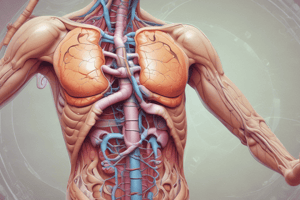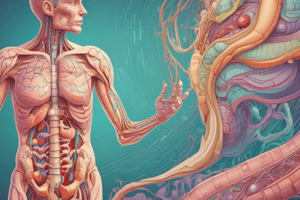Podcast
Questions and Answers
What is a key function of secretin in gastric activity regulation?
What is a key function of secretin in gastric activity regulation?
Which type of chyme is known to be digested more slowly and causes food to remain in the stomach longer?
Which type of chyme is known to be digested more slowly and causes food to remain in the stomach longer?
Which hormonal mechanism is directly involved in inhibiting gastric secretion and duodenal filling?
Which hormonal mechanism is directly involved in inhibiting gastric secretion and duodenal filling?
What type of reflexes primarily act through the enteric nervous system to influence gastric secretion?
What type of reflexes primarily act through the enteric nervous system to influence gastric secretion?
Signup and view all the answers
Which substance increases both gastric motility and intestinal motility?
Which substance increases both gastric motility and intestinal motility?
Signup and view all the answers
Where does the most vigorous peristalsis and mixing occur in the stomach?
Where does the most vigorous peristalsis and mixing occur in the stomach?
Signup and view all the answers
What effect does GIP (gastric inhibitory peptide) have on gastric contractions?
What effect does GIP (gastric inhibitory peptide) have on gastric contractions?
Signup and view all the answers
Which mechanism primarily regulates gastric emptying?
Which mechanism primarily regulates gastric emptying?
Signup and view all the answers
What is the role of pacemaker cells in gastrointestinal smooth muscle contraction?
What is the role of pacemaker cells in gastrointestinal smooth muscle contraction?
Signup and view all the answers
What is the primary function of peristalsis in the gastrointestinal tract?
What is the primary function of peristalsis in the gastrointestinal tract?
Signup and view all the answers
Which of the following is NOT a factor influencing gastrointestinal tract motility?
Which of the following is NOT a factor influencing gastrointestinal tract motility?
Signup and view all the answers
What is the primary neurotransmitter involved in the excitatory function of the parasympathetic nervous system on gastrointestinal motility?
What is the primary neurotransmitter involved in the excitatory function of the parasympathetic nervous system on gastrointestinal motility?
Signup and view all the answers
How does the enteric nervous system contribute to gastrointestinal motility?
How does the enteric nervous system contribute to gastrointestinal motility?
Signup and view all the answers
What is the role of sphincter tone and relaxation in gastrointestinal motility?
What is the role of sphincter tone and relaxation in gastrointestinal motility?
Signup and view all the answers
Which of the following is NOT a function of motility in the gastrointestinal tract?
Which of the following is NOT a function of motility in the gastrointestinal tract?
Signup and view all the answers
What is the primary function of segmentation in the gastrointestinal tract?
What is the primary function of segmentation in the gastrointestinal tract?
Signup and view all the answers
Study Notes
Overview of the Digestive System
- The digestive system is responsible for breaking down food, absorbing nutrients, and expelling waste.
- Major components include salivary glands, stomach, pancreas, and bile system.
Digestion and Absorption of Nutrients
- Involves mechanical and chemical processes through enzymes and acids.
- Nutrients are absorbed primarily in the small intestine.
Salivary, Gastric, and Pancreatic Secretions
- Saliva contains enzymes that initiate digestion.
- Gastric secretions include hydrochloric acid and pepsin for protein breakdown.
- Pancreatic secretions are rich in enzymes that further digest carbohydrates, fats, and proteins.
Bile and Biliary System
- Bile aids in the digestion and absorption of fats.
- Produced in the liver and stored in the gallbladder.
Motility of the Gut
- Gastrointestinal motility includes two key functions: mixing and propulsion.
- Depends on interactions between smooth muscle, the enteric nervous system, and hormones.
Smooth Muscle Contractions
- Gastric contractions are facilitated by the visceral smooth muscle.
- Interstitial Cells of Cajal act as pacemaker cells, generating rhythmic contractions.
Patterns of Motility
- Peristalsis: Coordinated waves that move a bolus through the digestive tract.
- Segmentation: Local contractions that churn and fragment the bolus for better digestion.
Neural Control of Gastrointestinal Motility
- Involves the enteric and autonomic nervous systems.
- Parasympathetic stimulation (via the vagus nerve) enhances motility.
- Sympathetic effects tend to inhibit gastrointestinal activity.
Hormonal Control of Gastrointestinal Motility
- Key hormones include:
- Gastrin: Promotes stomach activity.
- Cholecystokinin (CCK): Stimulates gallbladder contraction and inhibits stomach activity.
- Gastric Inhibitory Peptide (GIP): Inhibits gastric contraction.
- Motilin: Stimulates gastric and intestinal motility.
Regulation of Gastric Emptying
- Controlled by neural reflexes and hormonal mechanisms.
- Carbohydrate-rich chyme moves quickly through the duodenum, whereas fatty chyme is digested more slowly.
Effects of Filling on Stomach Activity
- Vigorous peristalsis and mixing occur near the pylorus.
- Chyme is either delivered to the duodenum in small amounts or mixed further in the stomach.
Local and Central Reflex Pathways
- Short reflexes (entirely within the ENS) manage local responses.
- Long reflexes involve the CNS and can modify autonomic activity affecting gastric motility and secretion.
Studying That Suits You
Use AI to generate personalized quizzes and flashcards to suit your learning preferences.
Related Documents
Description
Quiz on lectures covering the digestive system, including digestion, absorption, and physiology of the gut. Topics include salivary, gastric, and pancreatic secretions, bile and biliary system, and motility of the gut.



